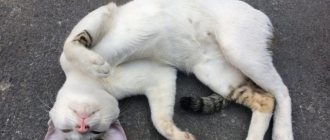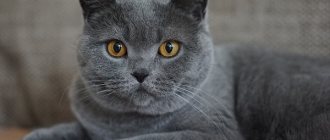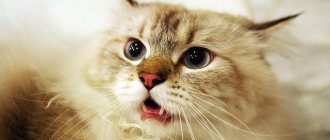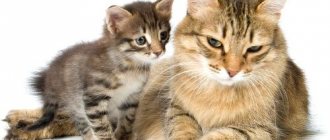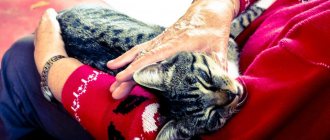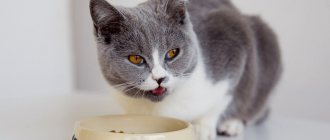Why does a cat always sit in one place?
Your cat always sits in one place to serve two purposes: first, by leaving his scent on the chair, your cat can feel more comfortable resting there, and second, it is also a sign of dominance to ward off other animals.
Don't worry, this doesn't mean your cat thinks you're smelly or anything. If your cat enjoys spending time with you there, "marking" her with a familiar scent will simply ensure that your cat will be comfortable spending many happy hours with you in that place.
© shutterstock
How to understand a cat: sounds
Meow
Meowing can be used to express anything. It can mean a greeting (long time no see!), an order (take it in your arms, let it go, feed it), an objection (better not touch it), an announcement (here’s a mouse for you). Cats use most types of meows to communicate with people, but sometimes it happens that a cat walks around the house and meows to itself.
Purring
With the help of these sounds, the mother cat encourages the kittens to follow her. When a cat makes such a sound towards you, perhaps it is her way of calling you somewhere. Usually towards a plate or toys.
Cats living together often communicate with each other in this way.
Purr
This is usually a sign of pleasure. Cats can always purr with pleasure, even when they eat. But it can also mean a lot of things, from excitement to pain.
Growling, hissing and spitting
And without a translator, it is clear that the cat is very irritated and angry, and it is better to leave it alone.
Howls
This sound can be described as a loud, drawn-out meow. It usually means that the cat is in an unpleasant situation, for example, locked in a closet, looking for you, or something hurts. If you hear howling, you should look for the cat and check if anything has happened to it.
Unneutered cats and female cats make such sounds during the mating season. And in older cats, howling can be a sign of dementia and means that the cat is disoriented.
Are cats more comfortable in the same place?
When your cat consistently sleeps in a favorite spot, she will immediately feel relaxed and comfortable.
Although our sense of smell is not as good as domestic cats, you can compare it to visiting your parents' house. There are certain scents, like mom's cooking, dad's cigars, old books... little things that make you feel more at ease and make you feel at home.
Why does a cat stay in the same place for hours?
If your cat is usually quite playful, then staying in one area for an extended period of time could be a warning sign. This could indicate a number of things such as pain, anemia, shock or even internal bleeding, so a visit to the vet is a good idea (just in case).
Cats certainly like to stay in the same place for long periods of time when they're older, of course, but if your cat is usually quite lively and now seems mostly lethargic, you'll need to get this checked out as soon as possible. to avoid any possible injury or damage.
Other diseases Unnatural behavior or posture in a vetna cat
Sometimes, for no apparent reason, your pet suddenly changes its daily behavior. The owner should be wary - this may be a sign of a disease that can only be diagnosed by a veterinarian. Before going to the clinic, you should take a closer look at the cat. Immediately go to the doctor if she refuses food and drink, reacts painfully to being touched or picked up, her breathing rhythm changes, her fur is tousled, does not fit correctly to her body, the cat takes unnatural positions when walking, sitting or lying down. All this is a sign of several diseases, including inflammatory processes of internal organs, poisoning, serious injuries (falling from a height, beating, etc.). Unnatural behavior and posture may not be associated with any disease. The fact is that the behavior of an animal is changeable, due to age, biological characteristics (readiness for fertilization, childbirth, etc.), ethology (the natural disposition and habits of the animal are determined), and the lifestyle of the owners themselves. Pets adapt to certain living conditions based on personal experience. Also, it has been scientifically proven that animals are susceptible to changes in the electromagnetic field of the Earth, therefore the behavior in which it rushes around the territory (house, yard, etc.), and then suddenly calms down, huddled somewhere (lasts about 24-48 hours) - indicates the likelihood of a natural disaster or earthquake within a radius of 100-150 km from the epicenter. The owner should be alarmed by the appearance of the symptoms listed at the beginning of the article. If a cat behaves unnaturally, takes positions that are unusual for it, first of all, this is a sign of illness or injury. Any slightest change in the behavior of a pet that is not inherent in its lifestyle in a healthy state is already a signal for immediate observation, a step towards qualified consultation.
Possible reasons for behavioral changes
The owner notices the fall (beating) of the animal as soon as possible. Symptoms: stops actively moving (even to the point of lying in one position for a long time), unable to approach food, water (or cannot take the correct position for eating); meows pitifully (especially if touched or lifted), lethargic, breathes heavily; signs of mechanical damage are visible on the body (blood, bumps, dislocations, limping, etc.). To avoid consequences from bruises and fractures, you should immediately show your cat to a veterinarian. Symptoms of tetanus: sudden short-lived (clonic) convulsions, when after each muscle contraction there is a relaxation; Coordination is impaired, it is difficult to open the jaw, etc. There may be tonic spasms: the muscles are in a state of contraction-relaxation for a long time, and the animal’s body seems to become stiff. Similar abnormal behavior also occurs with other infectious, viral, bacterial diseases (including toxicosis from the presence of helminths), or with pathology of systems in the cat’s body. Symptoms that occur with rabies: excessive affection of the pet is sharply replaced by aggression; can throw itself at inanimate objects (things, trees, fences); swallows inedible objects; aggressiveness towards other living beings (people, animals), increased salivation. The second stage of rabies is characterized by photophobia and hydrophobia (hides into darker places, is afraid to drink), excessive timidity, convulsive movements are observed (as if catching flies with its teeth), prolonged meowing (similar to howling or other sounds that are not characteristic of a cat). Inflammatory processes in the animal’s body and poisoning are the most difficult to diagnose for the owner. An exacerbation of the disease is easier to notice, since the pet’s behavior suddenly takes on an unnatural form: changes in temperature, attacks of pain are accompanied by an angry hissing (even growling), loud meowing, the cat takes unnatural positions in order to lie down and ease the pain in a certain area; Neuralgic attacks occur (convulsions, throwing the head back, etc.); nervousness (throwing around, frequent licking), the gaze becomes glassy, as if going nowhere. In the chronic course of the disease, the animal becomes apathetic, refuses to eat, stops caring for itself, refuses to go for walks, etc. Other reasons for unnatural behavior: changes in gait, reluctance to move, may indicate an accidental injury while walking. If a cat is constantly on its feet, refuses to lie down or sit down, it may have chest and stomach pain. There are a lot of reasons, ranging from bruises to intestinal obstruction. In any case, even if you know the reason for unnatural behavior or posture, consult a specialist. Your pet will be grateful for the speed of assistance provided for a quick recovery. Dear readers, this article is not a tutorial or instructions for self-treatment of cats. The animal needs the help of a specialist, because only in a clinical setting, based on research, using appropriate equipment, will the diagnosis be correctly established. Any delay or unqualified treatment can cost your pet’s life. Take care of your pet's health.
Is it normal for a cat to stay in the same room most of the day?
Cats are territorial and sometimes they have a favorite room where they like to spend time. Perhaps they like to look out the window, or there is a particularly comfortable spot that gets some sun where the cat likes to spend part of the day.
© shutterstock
However, if your cat comes into the room and only comes out for potty breaks, then it deserves a little more attention.
Cats will sometimes hide in a room if they are scared, and a little coaxing with a string of yarn across the floor or playing with a laser pointer can lure them a little outside their comfort zone.
If your cat hides and won't even come out for potty breaks, then you have a problem. This may indicate that your cat is sick or injured, and when you notice this behavior, it's time to visit your veterinarian to rule out any injuries that may be hidden from view.
How to understand a cat: body language
Cats communicate using their bodies. Signs are given by the eyes, ears, tail, back, posture in general. To understand a cat, sometimes you have to compare several signs, which individually can mean completely different things. Over time, this begins to happen on its own.
Ears
- forward-looking: interested, alert, content
- directed back or to the sides, parallel to the head (“airplane”): irritated, angry, scared
- rotate, move: listens carefully to every sound
Eyes
- pupils constricted: ready to attack or perhaps pleased
- dilated pupils: nervous or docile (if slightly dilated), defensive or playful (if very dilated)
Tail
- straight, raised up: alert, curious or happy
- with fluffy fur: angry or scared
- very low or tucked up: worried, unsure
- moves sharply from side to side: excited, excited (the faster the tail moves, the more angry the cat is)
- raised up, quivering, with a curved tip: delighted, happy
Body
- the back is arched, the fur stands on end: scared or angry
- the back is arched, the fur lies: can be stroked
- lies on back, purrs: completely relaxed
- lies on her back, growls: upset and ready to attack
Description of the disease
Translated from Greek, dysplasia means “disorder, change in shape.” And this fully reflects the essence of the disease, in which improper development and formation of a tissue or organ occurs.
© shutterstock
Previously, it was believed that only dogs were susceptible to dysplasia, but over time, this pathology began to be diagnosed in cats, especially purebred ones. According to statistics, large breeds of cats suffer from dysplasia. Thus, among Maine Coon representatives the probability of developing pathology is 18%. Breeds such as Norwegian Forest, British, Scottish, and Persian are also at risk.
Cats are diagnosed with two types of joint dysplasia:
- Hip dysplasia is the most common and affects the lower limbs of the animal.
- Elbow dysplasia is much less common and is a pathology of the forelimbs in cats.
Hip dysplasia in cats can occur at an early age, which has a significant impact on their later life. In this condition, the femur does not align properly with the pelvis. This means that the head of the femur moves relative to the pelvic cavity and a free space appears between them. With this pathology, the connective tissue is the first to be affected, and then the bones are deformed.
With forelimb dysplasia, the bones may not fit together due to their shape or size. In addition, microcracks may appear in the lower part of the bones or they may increase due to salt deposition.
Due to improper development and deformation of the joints, excessive mobility occurs. Over time, the friction of the joint elements increases, and the pressure on them increases significantly. As a result, bone and cartilage tissue are destroyed and many diseases of the musculoskeletal system develop.
Main reasons for seeking shelter
There are many explanations for why a cat hides in dark places. In some cases, the shelter is not always truly dark, but simply cool or, conversely, warm. There may be several favorite places for a pet, often they are well known to the owner. It is advisable not to disturb the animal at such a moment, because sometimes he needs to be alone with himself.
Why does a cat try to be invisible, let's name common reasons:
- character trait;
- the presence of another, older cat in the house;
- the need to calm down after suffering stress;
- anticipation of the appearance of offspring;
- desire to play;
- desire for security.
Timid by nature
By nature, some cats are sociable, while others prefer loneliness. Those who belong to the second category instinctively try to be “in the shadows” more often, which guarantees safety. Such a kitten will not sleep on a wide sofa with its tummy up, with its paws spread to the sides. Also, he will not once again catch someone’s eye. You can force him to come out of hiding with gentle words, a favorite treat, or a bright, entertaining toy.
If the cat is hiding, then you should not lure it out or put pressure on it. Perhaps something alarmed her, someone scared or offended her. She will go out on her own when she considers it necessary, wants to eat or take a walk. If you do not allow the predator to avoid an unpleasant situation, then its anxiety will only intensify.
Trying to get peace and comfort, even sociable cats hide. They may find a place for themselves in the linen closet or on the cool wooden floor under the bed. It all depends on whether the pet is cold or hot.
Away from the Boss
The presence of another cat or an older cat in the house causes the younger cat to hide more often. The owner can create a maze of boxes especially for him, through which he can easily get to a bowl of food or tray. The boxes must have multiple entrances and exits so that you can escape in time, avoiding a dangerous or unwanted collision with your opponent.
How to understand a cat: a guide to moods
These clues will help you understand what your cat is currently feeling and what mood she is in.
Lill Chin
Satisfied : sitting or lying, eyes half-closed, pupils constricted, tail almost motionless, ears directed forward, purring. A very happy cat will often stomp her paws on a soft surface, such as your lap.
Playful : Ears point forward, tail raised, pupils slightly dilated (play is a type of hunting behavior).
Irritated or overexcited : Pupils dilated, ears turned back, tail wagging or quivering, may make threatening warning sounds and may bite. After active play, many cats quickly become overexcited, go into a rage and begin to attack, bite and scratch.
Nervous or anxious : ears pointed to the side or back, pupils dilated, tail down or tucked. The cat walks half-bent, pressing against the floor, looking for shelter. In this state, the cat may sit facing the wall so as not to see the outside world.
Frightened or shocked : ears point back, pressed against the head, whiskers pressed to the muzzle, back arched, fur standing on end, tail raised or lowered. The cat may howl, growl, hiss and spit.
Defends itself : the body is bent, the ears are parallel to the head, the mustache is pressed to the muzzle, the tail is held between the legs or wrapped around the body, the pupils are dilated. The cat meows loudly, howls, hisses or spits.
Angry, aggressive : ears are laid back, pupils are extremely constricted, the tail can be raised or lowered, the fur stands up. An aggressive cat stares unblinkingly at its opponent and growls or howls until it retreats.
Cats do not like to fight and prefer to intimidate each other, but if the opponent does not give up, there will be a fight.

